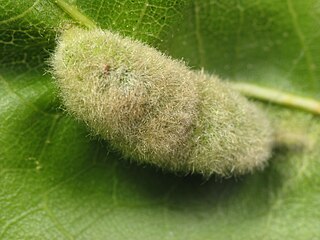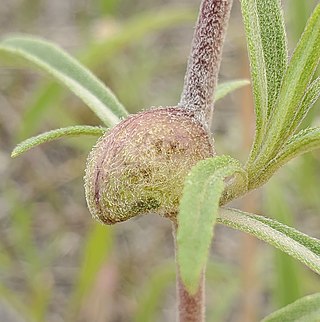
The Cecidomyiinae, commonly known as gall midges or gall gnats, is the largest subfamily in Cecidomyiidae with over 600 genera and more than 5000 described species. This subfamily is best known for its members that induce galls on plants, but there are also many species that are fungivores, parasitoids, or predators as maggots.

Contarinia is a genus of midges, small flies in the family Cecidomyiidae. There are over 300 described species in the genus.

Rabdophaga is genus of flies in the family of gall midges Cecidomyiidae. There are 105 species distributed through Africa, Asia, Europe and North America. Most species of Rabdophaga gall willows ; one exception is R. giraudiana which galls the stems of poplars.

Schizomyia is a genus of gall midges. It has a cosmopolitan distribution.

Caryomyia is a genus of hickory gall midges in the family Cecidomyiidae. They are often known as the hickory gall midges since most species feed on various species of hickory. There are at least 30 described species in Caryomyia.
Polystepha is a genus of gall midges in the family Cecidomyiidae. There are more than 20 described species in Polystepha.

Macrodiplosis is a genus of gall midges, insects in the family Cecidomyiidae. There are about 19 described species in Macrodiplosis.
Asphondylia betheli is a species of gall midge in the family Cecidomyiidae. This midge is widespread in the southwestern United States. The larvae of this species induce galls on in the fruit of Opuntia cacti.

Asphondylia helianthiglobulus is a species of gall midge in the family Cecidomyiidae. The larvae of this species induce galls on the stems of several sunflower species in eastern North America, including Helianthus giganteus,H. grosseserratus, and H. maximiliani.

Asphondylia rudbeckiaeconspicua is a species of gall midges in the family Cecidomyiidae. The larvae induce galls on Rudbeckia laciniata in North America. It was first described by Carl Robert Osten-Sacken in 1878.

Asteromyia is a genus of gall midges in the family Cecidomyiidae. There are about nine described species in Asteromyia.
Resseliella is a genus of gall midges in the family Cecidomyiidae. There are at least 50 described species in Resseliella.

Blaesodiplosis is a genus of gall midges in the family Cecidomyiidae. There are at least four described species in Blaesodiplosis.

Ampelomyia vitispomum is a species of gall midge in the family Cecidomyiidae. It induces galls on grape plants in eastern North America. It was first described by Carl Robert Osten-Sacken in 1878.

Asphondylia solidaginis is a species of gall midge (Cecidomyiidae) that induces galls on goldenrods in North America where it is widespread. It was first described by William Beutenmuller in 1907.
Acericecis is a genus of gall midges in the family Cecidomyiidae. There are at least three described species in Acericecis.
Raymond J. Gagné is an American entomologist whose work focuses on gall midges.
Asphondylia amaranthi is a species of gall midge in the family Cecidomyiidae.















